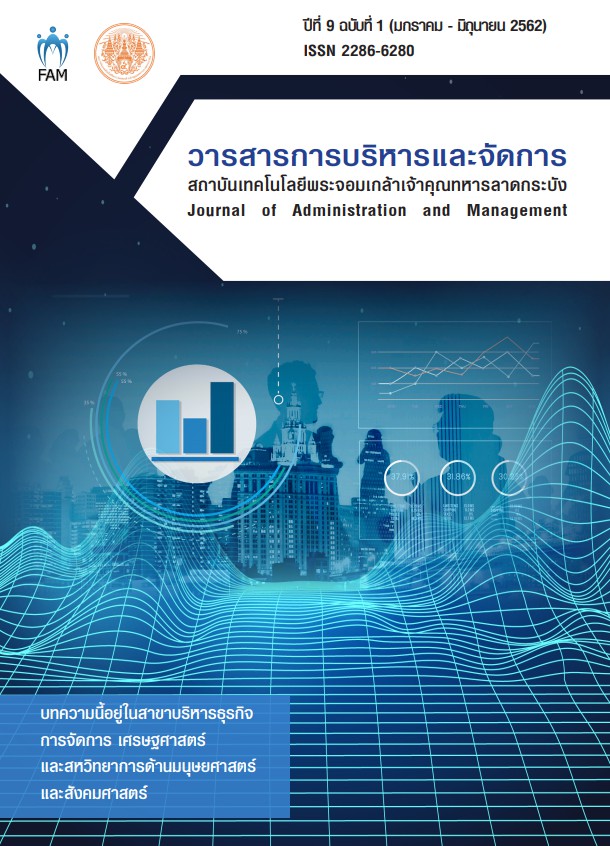SERVICE QUALITY AND SERVICE MARKETING MIX IN USING HEMODIALYSIS IN GOVERNMENT HOSPITAL, CENTRAL REGION
Main Article Content
Abstract
The objective of this research was to study and compare the service quality and marketing mixes of using hemodialysis in government hospital, classified by personal factors. The 400 samples came from multi-stage sampling. They are end-stage renal patients who had used the hemodialysis service in government hospital, central region. The research applied the questionnaire for data collection. The statistics for analysis included frequency, percentage, mean, and standard deviation. The hypothesis testing consisted of t-test, One-way ANOVA, and LSD. According to the study, it was found that samples give priority to the service quality of using hemodialysis in government hospital, for ascending to descending means as follows: responsiveness, empathy, reliability, assurance, and tangibility. Meanwhile, the priority of the marketing mixes using hemodialysis in government hospital, from ascending to descending mean, are as follows: personnel, product, process, physical appearance, price, place, and promotion, respectively. Regarding the hypothesis testing, it was discovered that the users who have the difference personal factors give the different priority to the service quality and marketing mixes of using hemodialysis in government hospital, central region with statistical significance at 0.01 and 0.05.
Article Details
Journal of KMITL Business School is available both online and in printed version.
**All articles or opinions presented in this issue of the Journal of KMITL Business School reflect the thoughts of their respective authors. This journal serves as an independent platform for a variety of viewpoints. Authors bear full responsibility for the content of their articles.**
**All articles published in this journal are copyrighted by KMITL Business School, King Mongkut's Institute of Technology Ladkrabang. The editorial team permits copying or using articles, but a reference to the journal is required.**
References
กาญจนา พิบูลย์. (2559). ความต้องการในการจัดบริการการดูแลผู้สูงอายุแบบไปกลับ. วารสารสาธารณสุขมหาวิทยาลัยบูรพา, 11(2): 44-51.
ประเสริฐ ธนกิจจารุและสุพัฒน์ วาณิชย์การ. (2551). ตำราการฟอกเลือดด้วยเครื่องไตและการพยาบาล. กรุงเทพฯ: มูลนิธิโรคไตแห่งประเทศไทย.
มณีรัตน์ จิรัปปภา. (2557). การชลอไตเสื่อมจากวัยผู้ใหญ่ถึงวัยสูงอายุ. วารสารวิทยาลัยพยาบาลบรมราชชนนี นครราชสีมา,20(2): 5-16.
สมาคมโรคไตแห่งประเทศไทย. (2017). Annual Report Thailand Renal Replacement Therapy 2015th. สืบค้นเมื่อ 6 เมษายน 2561. เข้าถึงได้จาก http://thailand-renal-replacement-therapy-2007-2015-th.
อมรรัตน์ ศรีวาณัติ. (2560). ความพึงพอใจต่อคุณภาพบริการของผู้ป่วยฟอกเลือดด้วยเครื่องไตเทียมในศูนย์ไตเทียมเอกชน ในเขตกรุงเทพมหานครและปริมณฑล. วารสารพยาบาลตำรวจ, 9(1): 187-196.
Coleman S. Havas K. Ersham S. Et all. (2017). Patient satisfaction with nurse-led chronickidney disease clinics : A multicentre evaluation. Journal of Renal Care. 43(1) : 11-20.
Gu X. and Itoh K. 2015. Factors behind dialysis patient satisfaction : exploring their effects on overall satisfaction. สืบค้นเมื่อ 30 พฤษภาคม 2561, จาก https://www.ncbi.nlm.nih.gov/pubmed/2536387
Parasuraman A., Zeithaml V.A. And Berry L.L. (1988). SERVQUAL : A multiple Item Scale for measuring consumer perceptions of service quality. สืบค้นเมื่อ 30 พฤษภาคม 2561,จาก https://www.researchgate.net/publication/225083802_SERVQUAL_A_multiple-_Item_
Scale_for_measuring_consumer_perceptions_of_service_quality.
Philip Kotler. And Kevin Lane Keller. (2016). Marketing Management. 16th ed. New York: Pearson.
Suetonia C Palmer. Giorgia de Berardis. And Jonathan C Craig. Et all. (2014). Patient satisfaction with in-centre haemodialysis care : an international survey. BMJ Open. 4(5) : 14


